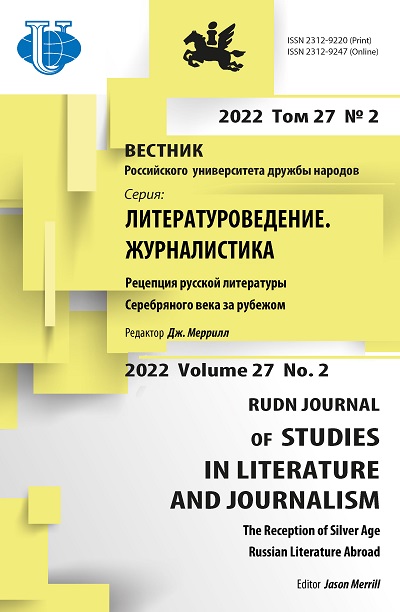Revising the Assessment of Creative Competence of Journalism Students
- Authors: Gavrilov V.V.1
-
Affiliations:
- Surgut State Pedagogical University
- Issue: Vol 27, No 2 (2022): THE RECEPTION OF SILVER AGE RUSSIAN LITERATURE ABROAD
- Pages: 388-398
- Section: JOURNALISM
- URL: https://journals.rudn.ru/literary-criticism/article/view/31464
- DOI: https://doi.org/10.22363/2312-9220-2022-27-2-388-398
- ID: 31464
Cite item
Full Text
Abstract
This study proposes an effective development methodology for evaluating the creativity of journalism students. Within the framework of university education, it is proposed to focus the attention of teachers on creating a special educational environment (media park), where progressive forms and methods of teaching, game methods are used systematically, in the context of the ecology of media processes. The peculiarity of the methodology is that at the end of the educational process (the creation of a specific media product by the students), its effectiveness is measured by comparing the initial and final indicators of the creative competence of student journalists. The author proposes to use S. Mednik’s speech-thinking creativity test, which is based on an assessment of the level of development of the student’s thinking and speech in their relationship, which is extremely important for future journalists. The article presents the results of the practical application of this type of assessment. The relevance and novelty of the problematic are due to the following circumstances. On the one hand, active forms and methods of teaching, including project activities, are widely used in universities, on the other hand, the methodology for assessing the creative competence of students is currently not well developed and is practically not used in the curriculum. It should also be recognized that the assessment of this competence and the products of creativity in general, which, of course, includes a journalistic text, is complex and ambiguous, since it is influenced by a large number of subjective factors. This article proposes one of the ways to resolve this contradiction.
About the authors
Viktor V. Gavrilov
Surgut State Pedagogical University
Author for correspondence.
Email: victorg12@mail.ru
ORCID iD: 0000-0002-1279-3066
Candidate of Pedagogical Sciences, Associate Professor of the Department of Philological Education and Journalism
10/2 50 let VLKSM St, Surgut, 626417, Russian FederationReferences
- Artemova, Yu.V. (2021). Training a journalist at a university: development of professional competencies: study guide. Yelets: Yerevan State University Bunin.
- Artemova, Yu.V., & Artemov, A.S. (2020). Development of creative activity of students in the educational space of the university. In Psychology of education in a multicultural space, 50(2), 58–65.
- Druzhinina, V.N., & Galkina, T.V. (Ed.). Methods of psychological diagnostics. Moscow: Institute of Psychology of the Russian Academy of Sciences, 1993.
- Ershov, Yu.M. (2016). Models of Journalism Education in the Digital Age // Journalistic Yearbook, (5), 13–16.
- Ilyicheva, V.V., & Kuzmenkova, K.E. (2015, April 9). Multimedia portal as a platform for the development of professional skills. In Problems of modern radio broadcasting: materials of the 1st scientific and practical conference (pp. 32–38). V.V. Barabasha (Ed.). Moscow: RUDN University.
- Khutorskoy, A.V. (2011). Definition of general subject content and key competencies as a characteristic of a new approach to the design of educational standards. Bulletin of the Institute of Human Education, (1). Retrieved January 29, 2022: https://eidos-institute.ru/journal/
- Malakhova, N.N., & Bessarabova, O.N. (2014). Formation of creative competence in the education system of an innovative society. Humanitarian, socio-economic and social sciences, (1), 139–143.
- Oleshko, V.F. (2016). Print media in the context of new models of information interaction with the audience. Journalism of the digital era: how the profession is changing: materials of the Intern. scientific-practical. Conf. 2016, April 14–15 (pp. 59–62). Yekaterinburg.
- Shesterkina, L.P., & Marfitsyna, A.R. (2019). Project journalism and modern trends in journalism education. Scientific notes of the Transbaikal State University, 14(1), 40–48. https://doi.org/10.21209/2658-7114-2019-14-1-40-48
- Smolkin, A.M. (1991). Methods of active learning. Moscow: Higher school.
- Temnyatkina, O.V. (2009). Evaluation of the results of education of students of educational institutions of NGOs and secondary vocational education based on a competency-based approach. Toolkit. Yekaterinburg, IRRO. URL: http://rudocs.exdat.com/docs/index-39066.html?page=4 (accessed: 29.01.2022).
- Trushevskaya, A.A. (2013). Development of coaching technologies in the educational space of the university. Problems of modern economics, 45(1), 227–231.
- Vodyakha, S.A. (2012). Creative competence: approaches to measurement // Assessment of the quality of education in educational institutions: a collection of scientific articles (рp. 28–33). Ekaterinburg: Ural State Pedagogical University. Yekaterinburg.
- Volkova, I.I., Desyaeva, N.D., Kilpelyainen, E.S., & Algavi, L.O. (2017). Gamification in education: a duel with the boss. In Educational space in the information age (EEIA-2017): collection of scientific papers of the international scientific and practical. conferences, Moscow, (June 7–8, pp. 330–340). Moscow: Institute for Education Development Strategy RAO.
- Volkova, I.I., Urazova, S.L., & Pisareva, M.N. (2020). Criteria for the formation of a communicative space in the student environment: immersion in creativity // Uchenye zapiski Zabaykalskogo universiteta, 15(1), 75–81.
Supplementary files















